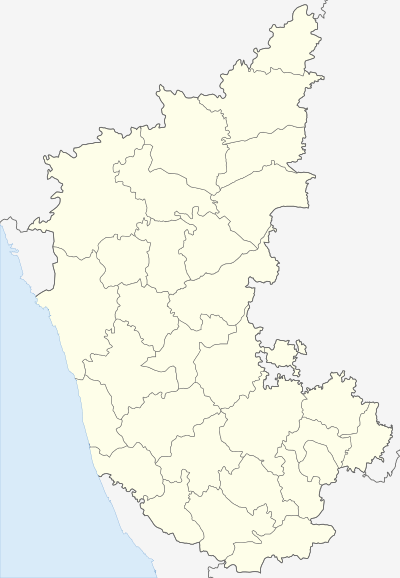Kanaganahalli
| Kanaganahalli Kanganhalli | |
|---|---|
| Village | |
 Kanaganahalli Location in Karnataka, India | |
| Coordinates: 17°07′N 77°05′E / 17.12°N 77.08°ECoordinates: 17°07′N 77°05′E / 17.12°N 77.08°E | |
| Country |
|
| State | Karnataka |
| District | Gulbarga |
| Area | |
| • Total | 1.5 km2 (0.6 sq mi) |
| Languages | |
| • Official | Kannada |
| Time zone | IST (UTC+5:30) |
| PIN | 585 211 |
| Telephone code | 08474 |
| Nearest city | Chitapur |
Kanaganahalli is about 3 km from Sannati. An important Buddhist site, the place where an ancient Buddhist Mahastupa site found. It is on the left bank of the Bhima river[1] in Chitapur taluk, Gulbarga District in Karnataka, India. Nalwar is the nearest Railway station about 19 km from Kanaganahalli. The Buddhist site about 2.5 km from Chandrala Parameshwari temple of Sannati.
History
The remains of the excavations site at Kanaganahalli can be dated to between the 1st century BC to the 3rd century AD.
In circa the 1st century BC the stupa at Kanganhalli was constructed, as per the inscriptions referred to as Hama Chaitya and it was patronized by the Hinayana and Mahayana people during the 3rd and 4th centuries AD. In the pre-Christian times with the advent of Shatavahana, the Amaravati School of art made a deep impact on the sculptural and architectural forms of Kanaganahalli region. This was indeed a period of great artistic efflorescence that gave the Maha chaitya here the most impressive form unsurpassed in the history of stupa architecture in the south India.[2]
The sculptured panels of the medhi are distinctly of native creation. The skill of making two dimensional sculptures and the carving of typical animal motifs are also of indigenous nature. Exhibit a transition phase between the early phase of Amaravati sculptural art and the elaborately sculptured panels of Nagarjunakonda with the sculptural panels found at Kanaganahalli stupa.
The volumes of their improvement over their Amaravati counterparts. The mastery of the artist of Kanganhalli in carving the geometric patterns, floral motifs, dress and ornamentation of the contemporary times and the concept of composition of the subject matter in the large sculptured panels.
The Kanaganahalli Maha Stupa is the veritable gallery of eminent rulers like King Ashoka and the Shatavahana rulers (Simuka, Pulumavi) are immortalized by depicting their portraits at Kanaganahalli.
Unlike the torana of Sanchi, Madhya Pradesh, portrait of emperor Ashoka is said to have depicted there is inscription found at Kanaganahalli.
At Kanganhalli up to the anda portion of the stupa is available, although majority of the architectural members and the sculptural panels are dislodged from the original position.
ASI Excavation Site
Kanaganahalli is the excavation site of the Archaeological Survey of India.[3]
Excavation during 1994 to 1998
- During the excavations (1994 to 1998) at Kanaganahalli, found remains of a massive Stupa, many brick structures in the form of a Chaitya-griha and votive stupas were brought to light.
- During the excavations many architectural members of the stupa found like fragments of sculptured veneering slabs, members of railings, pillars, capitals, Buddha padas, sculptures of yaksha and four images of Buddha many more.
- The sculptured panels depicts various Jataka stories and life of Lord Buddha
and portrait of many Shatavahana king.
Inscriptions
In addition to one long inscription, 145 short inscriptions were discovered from the excavations site, dating between 1st century BCE to 1st century CE. The very important discovery was the sculpture of Maurya emperor Ashoka with the label "Rayo Asoka".[4]
Excavation during 2000 to 2002
- During the excavations (2000 to 2002) found bare ruined remnants of a number of brick built structures like paved and sheltered passages connecting them. Also found part of a possible monastic complex to the north west of the main stupa.
- Antiquities such as lead coins bear names of Shatavahana king like Satakarni, Pulumavi and Yajnasri.
- The most important finding of the excavation include a stone sculptured slab bearing the name Raya Ashoka . The first inscribed portrait of Ashoka (surrounded by female attendants and queens) found at Kanaganahalli,[5] was unearthed from the ruined Buddhist stupa.
International Buddhist Centre
An important Buddhist site, Government of Karnataka and ASI Planning to develop Kanaganahalli ( and Sannati) as International Buddhist Centre.[6]
Government of Karnataka had constituted Sannati Development Authority and had appointed senior IAS official S.M. Jamdhar as its special officer.
See also
| Part of a series on |
| Buddhism |
|---|
 |
|
External links
- Rediscovering Ashoka, Vithal C Nadkarni, The Times of India, Mar 22, 2012
- Kanaganahalli - the Buddhist site
- Kanaganahalli Sannati conservation
- Relics of an emperor, LAKSHMI SHARATH, The Hindu, October 26, 2012
- Buddha circuit in Gulbarga
- Photographic documentation of the Kanaganahalli Stupa site - over 1,000 photos by C. Luczanits.
Notes
- ↑ "GULBARGA DISTRICT". Retrieved 2009-02-18.
- ↑ "Kanganhalli: A unique discovery of Buddhist site in India". Dr. D. Dayalan, Archaeological survey of india. Retrieved 2009-05-10.
- ↑ "Excavations - 2000-2005 - Karnataka". Retrieved 2009-02-18.
- ↑ Michael Meister, "Early Architecture and Its Transformations: New Evidence for Vernacular Origins for the Indian Temple," in The Temple in South Asia, ed. Adam Hardy, London 2007
- ↑ "Rediscovering Ashoka - Kanganhalli". Retrieved 2013-06-18.
- ↑ "Kanaganalli to be developed as International Buddhist Centre". The Hindu. Chennai, India. 2008-12-22. Retrieved 2009-02-18.